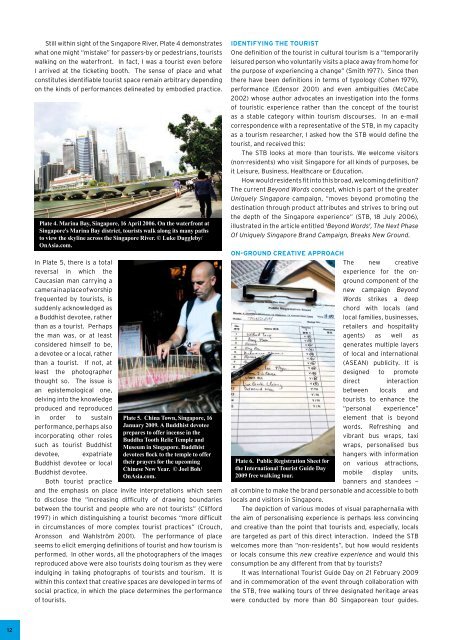Biblio asia - National Library Singapore
Biblio asia - National Library Singapore
Biblio asia - National Library Singapore
You also want an ePaper? Increase the reach of your titles
YUMPU automatically turns print PDFs into web optimized ePapers that Google loves.
Still within sight of the Sıngapore River, Plate 4 demonstrates<br />
what one might “mistake” for passers-by or pedestrians, tourists<br />
walking on the waterfront. In fact, I was a tourist even before<br />
I arrived at the ticketing booth. The sense of place and what<br />
constitutes identifiable tourist space remain arbitrary depending<br />
on the kinds of performances delineated by embodied practice.<br />
Plate 4. Marina Bay, <strong>Singapore</strong>, 16 April 2006. On the waterfront at<br />
<strong>Singapore</strong>'s Marina Bay district, tourists walk along its many paths<br />
to view the skyline across the <strong>Singapore</strong> River. © Luke Duggleby/<br />
OnAsia.com.<br />
In Plate 5, there is a total<br />
reversal in which the<br />
Cauc<strong>asia</strong>n man carrying a<br />
camera in a place of worship<br />
frequented by tourists, is<br />
suddenly acknowledged as<br />
a Buddhist devotee, rather<br />
than as a tourist. Perhaps<br />
the man was, or at least<br />
considered himself to be,<br />
a devotee or a local, rather<br />
than a tourist. If not, at<br />
least the photographer<br />
thought so. The issue is<br />
an epistemological one,<br />
delving into the knowledge<br />
produced and reproduced<br />
in order to sustain<br />
performance, perhaps also<br />
incorporating other roles<br />
such as tourist Buddhist<br />
devotee, expatriate<br />
Buddhist devotee or local<br />
Buddhist devotee.<br />
Both tourist practice<br />
Plate 5. China Town, <strong>Singapore</strong>, 16<br />
January 2009. A Buddhist devotee<br />
prepares to offer incense in the<br />
Buddha Tooth Relic Temple and<br />
Museum in <strong>Singapore</strong>. Buddhist<br />
devotees flock to the temple to offer<br />
their prayers for the upcoming<br />
Chinese New Year. © Joel Boh/<br />
OnAsia.com.<br />
and the emphasis on place invite interpretations which seem<br />
to disclose the “increasing difficulty of drawing boundaries<br />
between the tourist and people who are not tourists” (Clifford<br />
1997) in which distinguishing a tourist becomes “more difficult<br />
in circumstances of more complex tourist practices” (Crouch,<br />
Aronsson and Wahlström 2001). The performance of place<br />
seems to elicit emerging definitions of tourist and how tourism is<br />
performed. In other words, all the photographers of the images<br />
reproduced above were also tourists doing tourism as they were<br />
indulging in taking photographs of tourists and tourism. It is<br />
within this context that creative spaces are developed in terms of<br />
social practice, in which the place determines the performance<br />
of tourists.<br />
Identifying the Tourist<br />
One definition of the tourist in cultural tourism is a “temporarily<br />
leisured person who voluntarily visits a place away from home for<br />
the purpose of experiencing a change” (Smith 1977). Since then<br />
there have been definitions in terms of typology (Cohen 1979),<br />
performance (Edensor 2001) and even ambiguities (McCabe<br />
2002) whose author advocates an investigation into the forms<br />
of touristic experience rather than the concept of the tourist<br />
as a stable category within tourism discourses. In an e-mail<br />
correspondence with a representative of the STB, in my capacity<br />
as a tourism researcher, I asked how the STB would define the<br />
tourist, and received this:<br />
The STB looks at more than tourists. We welcome visitors<br />
(non-residents) who visit <strong>Singapore</strong> for all kinds of purposes, be<br />
it Leisure, Business, Healthcare or Education.<br />
How would residents fit into this broad, welcoming definition?<br />
The current Beyond Words concept, which is part of the greater<br />
Uniquely <strong>Singapore</strong> campaign, “moves beyond promoting the<br />
destination through product attributes and strives to bring out<br />
the depth of the <strong>Singapore</strong> experience” (STB, 18 July 2006),<br />
illustrated in the article entitled 'Beyond Words', The Next Phase<br />
Of Uniquely <strong>Singapore</strong> Brand Campaign, Breaks New Ground.<br />
On-ground Creative Approach<br />
The new creative<br />
experience for the onground<br />
component of the<br />
new campaign Beyond<br />
Words strikes a deep<br />
chord with locals (and<br />
local families, businesses,<br />
retailers and hospitality<br />
agents) as well as<br />
generates multiple layers<br />
of local and international<br />
(ASEAN) publicity. It is<br />
designed to promote<br />
direct interaction<br />
between locals and<br />
tourists to enhance the<br />
“personal experience”<br />
element that is beyond<br />
words. Refreshing and<br />
vibrant bus wraps, taxi<br />
wraps, personalised bus<br />
Plate 6. Public Registration Sheet for<br />
the International Tourist Guide Day<br />
2009 free walking tour.<br />
hangers with information<br />
on various attractions,<br />
mobile display units,<br />
banners and standees —<br />
all combine to make the brand personable and accessible to both<br />
locals and visitors in <strong>Singapore</strong>.<br />
The depiction of various modes of visual paraphernalia with<br />
the aim of personalising experience is perhaps less convincing<br />
and creative than the point that tourists and, especially, locals<br />
are targeted as part of this direct interaction. Indeed the STB<br />
welcomes more than “non-residents”, but how would residents<br />
or locals consume this new creative experience and would this<br />
consumption be any different from that by tourists?<br />
It was International Tourist Guide Day on 21 February 2009<br />
and in commemoration of the event through collaboration with<br />
the STB, free walking tours of three designated heritage areas<br />
were conducted by more than 80 <strong>Singapore</strong>an tour guides.<br />
12

















